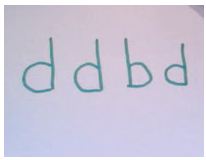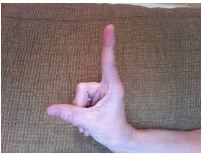Guest Blog: Correcting Letter Reversals
By: Dr. Anne Zachry
Reprinted with the express permission of the author as it originally appeared on her blog Pediatric Occupational Therapy Tips, April 16, 2011

Letter reversals are common for preschoolers and kindergarteners, but by the age of seven, reversals should only be occasional. Common letter reversals include b/d, n/u, p/q and m/w. Letter and word reversals that occur with writing are one of the symptoms of dyslexia, but this does not necessarily mean that every child who reverses letters has dyslexia. If a student is reversing letters and words on a consistent basis past seven years of age, or well into the third grade, parents may want to consider an evaluation by a professional to check for dyslexia or some other learning disability. Whether or not a child has been formally diagnosed with a learning disability, there are remedial strategies and activities that can help students practice the process of forming letters with proper directionality.
To address directionality, the first concepts that need to be understood are the directions of “right” and “left”. A good reminder for this concept is to have the child wear a watch or bracelet on the left hand. Another cue is to show the child that on the Left hand, you can make an “L” with your pointer finger and your thumb… L for Left, and on the right hand, the L is backwards. In the classroom, you can work on right and left throughout the day. When asking questions that require a hand to be raised, ask the children to raise the right or left hand. For example, who knows the answer to number five? Raise your right hand.

Rhyming techniques are also a good strategy. Just do a Google search on “rhymes for teaching left and right.” There are some great suggestions and cute rhymes that can serve as a reminder for remembering the right/left concepts.
Here are some more suggestions for addressing letter reversals.
- Make worksheets with rows of lower case letters. Start with letters that are easily distinguished and progress to those which are often reversed or seen upside-down.
- Tell the child to circle to letter that is “different”. After the exercise, ask the child questions such as “how is that letter different than the other?”
b b d b b
m n m m m
p p p q q
Then you can have the child make his own set of practice sheets. This is a great way to “feel” the differences in how the letters are formed. Use the suggestions on my previous post about kinesthetic handwriting instruction to work on the teaching the formation of commonly reversed letters.
There is also a great article on the Pediastaff website that addresses letter reversals…check it out http://www.pediastaff.com/resources-deal…-june-2008
There are also two activity workbooks that I frequently use with students who reverse letters or words. They are both available on Amazon, and I highly recommend them. Correcting Reversals and Correcting Word Reversals by Penny Groves.
Featured Guest Blogger: Dr. Anne Zachry, OTR/L PhD
Dr. Anne Zachry is a pediatric occupational therapist with over 18 years experience providing quality OT to children, along with caregiver instruction and support. She has a PhD in Educational Psychology. She’s had articles published in her profession’s trade magazine and in peer-reviewed journals. She is currently employed as a school therapist, working with students having issues ranging from mild fine motor problems to severe physical disabilities.
Please support our contributing authors and visit Pediatric Occupational Therapy Tips
PediaStaff is Hiring!
All JobsPediaStaff hires pediatric and school-based professionals nationwide for contract assignments of 2 to 12 months. We also help clinics, hospitals, schools, and home health agencies to find and hire these professionals directly. We work with Speech-Language Pathologists, Occupational and Physical Therapists, School Psychologists, and others in pediatric therapy and education.
